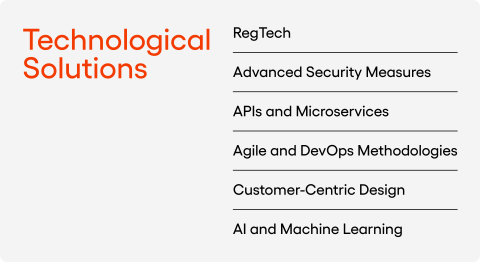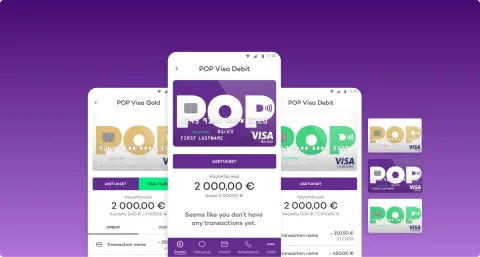Challenges and solutions in the banking product development process


The financial industry needs products that are high-quality, have extraordinary UX, and can deliver a high level of personalisation. That’s why the product development process must be continually improved and innovated. This way, it can meet the needs of banks and their customers, while navigating complex regulatory requirements and maintaining robust security.
This article discusses the challenges of developing products for banks, highlighting the most common problems and proposing technological solutions to overcome them. We will provide our recommendations, based on experience in building modern digital products for fintech start-ups and financial companies.
Table of contents
Importance of Effective Product Development
Effective product innovation in the banking sector is critical for several reasons. Well-prepared digital product drives revenue growth, especially when it introduces robust services that meet customers’ needs. It also enhances customer satisfaction thanks to user-friendly design and feature-rich, personalised architecture. It ensures regulatory compliance and security, mitigating risks associated with financial transactions, advisory services, and tax services, too. Investing in professional financial products’ development enables a bank to stay competitive in a highly competitive financial industry, fostering adaptability and constant readiness to answer consumers’ demands.
Moreover, new product creation facilitates a proactive approach to emerging market trends and ongoing changes. Banks that successfully embrace the digital world can anticipate shifts in customers’ preferences and respond to new tendencies, thus maintaining relevance among other market players. Additionally, a well-executed strategy when creating a new product can help banks diversify their revenue streams, reducing dependence on traditional banking services and enhancing overall financial stability.
Product Development Process Explained
Banking apps production involves several stages, from ideation to launch, each with its unique production scope, marketing needs, and risk profile. Unlike the majority of industries, banking products must adhere to strict regulatory standards and prioritise security due to the sensitive nature of financial data. Additionally, integration with legacy systems and the need for constant innovation add layers of complexity to the process.
Stages of the Product Preparation
Here’s an overview of steps involved in product creation:
- Ideation: This initial stage involves identifying market opportunities and understanding customer needs. Banks often leverage market research, customer feedback, and competitive analysis to generate a new product idea or expand the existing banking app with new features.
- Concept Development: During this phase, a bank and their product team define the product’s features, benefits, and value proposition. This stage requires close collaboration between different departments, including marketing, IT, and legal.
- Feasibility Analysis: A bank assesses the technical and financial viability of the proposed product. This involves evaluating the potential return on investment, identifying risks, and determining the resources required to create the banking app.
- Prototyping: Creating a proof-of-concept (PoC) and minimum viable product (MVP) is crucial to test the idea and make sure there’s customer demand for a proposed product. It’s the first prototype that can be then expanded into a full solution.
- Design and Development: This stage encompasses the creation of the product, including coding, user interface design, and backend development. Ensuring the product is user-friendly and aligns with regulatory requirements is on the partnering agency’s side.
- Testing and Validation: Before launch, the product undergoes rigorous testing to ensure it functions correctly and complies with regulations. This includes functional testing, security testing, user acceptance testing, and many other types of tests picked by the QA department based on specific project requirements.
- Launch: The final stage of development is introducing the product to the market. Effective marketing strategies and customer education are vital to ensure a successful launch. After the product is live, the banking company must monitor its performance and gather customer groups’ feedback to make necessary adjustments.
- Maintenance: Product development partners should propose an SLA agreement and take care of the solution after release. This includes introducing updates, fixing bugs, and developing the product further.
Common Challenges in the Product Development Process

Now it’s time to look closer at the most common challenges of the new product development. Awareness enables teams to minimise the risk of facing them. Moreover, it helps to react quickly when they occur nonetheless.
Regulatory Compliance
Navigating the complex and evolving landscape of financial regulations is a significant obstacle. Banks and other financial institutions must ensure that all products meet both local and international compliance standards, such as Basel III, GDPR, and PSD2. Non-compliance can result in large fines and reputational damage, which means it’s crucial to integrate compliance into early stages of creating banking products.
Regulations can vary significantly across different regions, requiring banking brands to tailor their products accordingly, depending on their target audience. This complexity is further compounded by frequent regulatory updates, necessitating constant adaptation. Finance companies must invest in compliance teams and technologies to stay abreast of these changes and ensure ongoing adherence to regulatory requirements.
Security Concerns
Protecting sensitive customer data from breaches and cyberattacks is paramount for any financial institution. Compliance with data protection laws is the best way to ensure safety. To achieve it, banks must implement advanced security measures, such as encryption, data confidentiality features, and all types of authentication, including biometric login.
In addition to external threats, banks must also address internal security risks. This includes establishing robust access controls, monitoring employee activities, and ensuring that all staff are trained on security best practices. With the increasing sophistication of cyberattacks, banks must continually enhance their security protocols to stay ahead of potential threats.
Integration with Legacy Systems
Many financial brands operate on outdated legacy apps, making the integration of new products and solutions a daunting task. Ensuring seamless data flow and compatibility with existing infrastructure requires significant time and resources. This challenge is compounded by the need to maintain uninterrupted service during the transition.
Legacy software often lacks the flexibility and scalability required for modern banking needs. This can hinder innovation and slow down the process. To overcome these challenges, money-related companies must invest in modernising their IT infrastructure, adopting more flexible and scalable technologies that can support future growth and innovation.
Innovation and Adaptation
Balancing innovation while also maintaining proper risk management is important. While there is a pressing need to keep up with tech advancements, a bank must carefully assess the risks associated with taking advantage of new technologies. Striking the right balance between these two approaches is crucial for sustainable market growth.
Innovation in banking often involves adopting emerging technologies, such as artificial intelligence (AI). While they offer significant potential benefits, they also introduce new uncertainties. Preparing robust risk management frameworks to evaluate and mitigate difficulties ensures that innovation does not compromise security or compliance.
Customer Expectations
In 2024 and beyond, customers will demand personalised and seamless banking experiences. Catering to diverse needs, preferences, and demographics requires banks to adopt a customer-centric approach. Meeting these expectations involves collecting and analysing large amounts of customer data from various sources (social media, customer feedback, surveys) to tailor sophisticated products and services.
Moreover, customers expect seamless integration across various channels, including web, mobile, and in-branch services. Providing a consistent and cohesive experience across all touchpoints is essential for enhancing customer satisfaction and loyalty. Investing in omnichannel strategies and adaptable technologies to deliver a unified customer experience plays critical role in addressing pain points of the customers.
Time-to-Market and Competition
In a very saturated market, speeding up the development cycle and ensuring timely product launch are critical. Delays can lead to missed opportunities and staying behind other banks. Money-related companies must streamline new product creation to stay ahead of new tendencies and rapidly changing market conditions.
Working with an experienced outsourcing partner is one of the best business strategy to achieve these goals. Accelerating time-to-market requires efficient project management, agile methodologies, and a focus on continuous improvement. Hired IT specialists are focused on minimising delays and delivering expected results as quickly as possible. This way, many banks can capitalise on emerging opportunities.
Backlog Management
Optimising the use of financial and human resources is essential when a bank wants to create a new product or add a new offering to their existing banking software. Managing a substantial backlog and ensuring efficient project prioritisation can be challenging, requiring robust project management and resource allocation strategies.
It’s another argument for hiring seasoned developers via a trusted outsourcing partner. Financial businesses can pick the most suitable financial model and pay for the specialists that actually work on the project. Moreover, they can scale the team whenever necessary.
Technological Solutions to Overcome Product Development Challenges

Knowing the potential obstacles that can be met along the way towards success, now it’s time to discuss the best approach to conquer them. Here’s what financial organisations can do to handle them the right way:
Regulatory Technology (RegTech)
RegTech utilises AI and machine learning to automate compliance processes, enabling real-time monitoring and reporting. These technologies can significantly reduce the burden of regulatory compliance, ensuring adherence to standards with greater accuracy and efficiency. RegTech solutions can also help fintech companies stay updated with legal changes, mitigating the risk of non-compliance.
Furthermore, RegTech can enhance transparency and accountability by providing detailed audit trails. This not only facilitates regulatory reporting but also helps banks identify and address potential issues proactively. By leveraging RegTech, banks can reduce compliance costs involved in existing product management and new product development.
Advanced Security Measures
Implementing multi-layered security protocols, such as encryption, biometrics, and AI-driven threat detection, can take data protection to the highest level. These measures help safeguard sensitive information and enhance customers’ loyalty. Additionally, adopting zero-trust security models and continuous monitoring can further strengthen security efforts.
Advanced security measures also involve leveraging modern methods for secure and transparent transactions. Investing in solutions that are highly resistant to fraud and other criminal activities provides an additional layer of security but also increases customer satisfaction since consumers expect banks to provide convenient payment gateways.
APIs and Microservices
Adopting APIs and microservices-based architecture facilitates quick, scalable, and flexible production. This approach enables banks to integrate new products with legacy systems seamlessly, enhancing interoperability and reducing project timeline. APIs also allow for better collaboration with third-party providers, expanding the range of services offered.
APIs and microservices enable banks to create modular, reusable components that can be easily integrated into existing systems. This not only accelerates the process but also enhances flexibility and scalability. By leveraging microservices and an API-first approach, banks can create a more agile and adaptable IT infrastructure, capable of supporting future growth and innovation.
Agile and DevOps Methodologies
Agile and DevOps methodologies promote iterative approach and faster releases through continuous integration and continuous delivery (CI/CD) practices. They enhance team collaboration, streamline workflows, and reduce time-to-market, enabling banks to respond swiftly to changes and customer needs. Established outsourcing companies always work on such frameworks to ensure quick delivery and high-quality results.
Agile methodologies emphasise flexibility, collaboration, and customer feedback, allowing banks to adapt quickly to changing requirements and deliver high-quality products. DevOps, on the other hand, focuses on automating and integrating production and operations processes, enhancing efficiency and reducing the risk of errors.
Customer-Centric Design
Applying UX design principles and utilising data about customers can help banks create personalised and user-friendly products. By focusing on the customer journey and addressing pain points, banks can deliver experiences that meet or exceed customer expectations, fostering loyalty and satisfaction.
Customer-centric design involves understanding customer needs, preferences, and behaviours, and using this information to create intuitive and engaging user experiences. This can be achieved through techniques such as preparing personas, journey mapping, and usability testing. By prioritising the clients’ experiences, banks can differentiate themselves in a competitive market and build lasting relationships with their customers.
AI and Machine Learning
AI and its advanced algorithms like machine learning can be utilised to personalise products and services, providing insights for better decision-making, automating internal tasks, and handling risk management. Predictive analytics can help banks anticipate customer needs, optimise marketing strategies, and identify potential risks, enhancing overall product effectiveness and customer engagement.
AI-driven chatbots and virtual assistants can also enhance customer service by providing instant, personalised support available 24/7. These technologies can handle routine inquiries, freeing up human agents to focus on more complex issues. Additionally, artificial intelligence can be used to detect and prevent fraud, enhancing security and protecting customer assets.
Product Development Done Right – Examples
To understand better how answering challenges proactively can positively influence the financial products’ development, we can have a closer look at case studies and success stories of financial companies that did it the right way.
POP Pankki

Our client, POP Pankki, is a Finnish cooperative bank, which successfully went through digital transformation to enhance its product offerings. We’ve prepared a mobile app for the bank from scratch, putting a strong focus on usability, legal compliance, and value-added services connected via API. The bank’s focus on innovation and customer-centricity has positioned it as a leader in the Finnish banking sector.
Thanks to our cooperation, POP Pankki increased their insurance sales by 20% and their overall profit increased by 126%. According to EPSI Rating 2019, our client achieved the highest level of customer satisfaction in Nordic countries. The app is used by approximately 40,000 people daily and has an average rating of 4.8 stars in app stores.
POP Pankki’s success can be attributed to its strategic investment in technology and commitment to customer satisfaction. Our team took these goals into consideration and created a product that met business objectives as well as consumer demands.
Monzo Bank
Monzo, a UK-based digital bank, exemplifies the successful integration of technology in banking development. It embraces modern technologies and robust solutions, with their infrastructure being held on Amazon Web Services (AWS).
Thanks to business models powered and automated by Google BigQuery and Google Cloud, the company reduced in-app support requests by 50% in just 10 months. Additionally, they’ve helped non-technical staff to start managing 85% of business intelligence tasks without the support of data scientists.
Currently, Monzo experiences steady growth with over 7.5 million customers on board and 1.6 million new clients in 2023. Their technology-first approach paid back with great results, marketing success, and positive opinions about the provider.
Best Practices in the Product Development Process
How to develop products for the banking industry and not fail? Here are our recommendations:
Customer Involvement
Engaging customers throughout the development cycle can provide valuable insights and ensure the final product meets their needs. This can be achieved through surveys, focus groups, and beta testing. Customer base involvement helps build banking products that are user-friendly and aligned with target market demands.
Involving customers early and often can help banks identify potential issues and refine their products based on real-world feedback. This iterative approach ensures that the final product is well-suited to customer needs and delivers a superior user experience.
Domain Knowledge
Having a deep understanding of the financial industry is essential for successful product development. This includes awareness of legal requirements, market trends, and customer preferences. It’s crucial to establish a continuous learning path that will allow banks to stay ahead of industry changes and emerging tendencies.
Domain knowledge enables banks to identify new opportunities and respond proactively to market shifts. Fostering research and development initiatives enables teams that work on banking products to deliver the best results in terms of quality, design, security, and compliance.
Picking the Right Partner
Choosing between in-house development and outsourcing is a critical decision. In-house teams offer greater control and internal knowledge, while outsourcing can provide access to specialised expertise, reduce costs, and save time. Banks should evaluate their specific needs and capabilities to determine the best approach.
When considering outsourcing, it’s essential to find a partner with a proven track record in the financial industry and a deep understanding of regulatory requirements. Establishing clear communication channels with the team and performance metrics is essential to ensure successful collaboration and alignment with strategic goals.
Conclusion
Building products for banks and financial brands is a long-term commitment that requires proper planning, detailed preparation, and execution with attention to detail. That’s why it’s so important to be aware of potential challenges to avoid. Working with a trusted partner that is experienced in preparing such products is a good first step. Banks should strongly invest in being in touch with customers, knowing regulatory requirements, and improving their security as well. Overall, with the right approach, strategic support, and end consumer in mind, the offered product has high chances to become a success and help the company grow.
Contact us if you need support in creating or improving a financial digital product for future-proof architecture, scalability, and exquisite UX.




